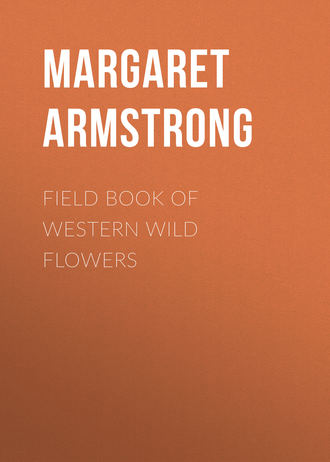 полная версия
полная версияField Book of Western Wild Flowers
Ookow
Brodiaèa congésta
Blue, violet
Spring, summer
Wash., Oreg., Cal.
Much like the last, except that only three of the stamens have anthers and the stem is sometimes as much as five feet tall. This grows on open hills in the Coast Ranges.
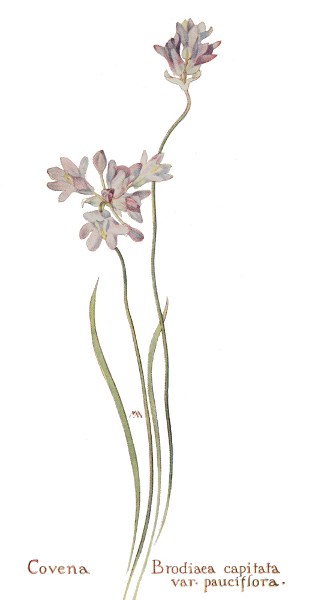
Covena – Brodiaea capitata var. pauciflora.
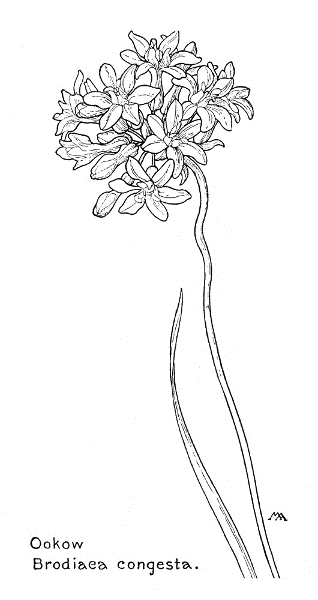
Ookow – Brodiaea congesta.

Harvest Brodiaea
Brodiaèa grandiflòra (Hookera coronaria)
Blue
Summer
Cal., Oreg., Wash.
In early June, at the time of the hay harvest, these handsome flowers, which look like clusters of little blue lilies, begin to appear among the dried grass of the hillsides and in open places in the woods. They vary in height from a few inches to over a foot and the number of flowers in a cluster also varies very much. Sometimes there are as many as ten of the beautiful blossoms, an inch or more long, with pedicels unequal in length and from one to four inches long, in a large cluster at the top of the stalk, with several, whitish, papery bracts at the base of the cluster. The color of the flowers is usually a deep bright blue shading to violet and the six divisions grow paler toward the base and have a brown stripe on the outside; the buds are greenish, striped with brown. The stamens are translucent white, three ordinary stamens, with long erect anthers, alternating with three without anthers, the latter tongue-shaped and petal-like. The leaves, which are thickish and about the same length as the stalk, have withered away before the flowers bloom. This plant very much resembles Ithuriel's Spear, Triteleia laxa, but three of the stamens are without anthers and the ovary is not on a long stalk. It is the commonest kind around San Francisco. B. minor is much the same, but a smaller plant with fewer and smaller flowers. The three outer divisions are narrow, with pointed tips, and the inner blunt and broad, and the sterile stamens are notched and longer than the fertile ones. This grows on dry hills and plains in middle and southern California.

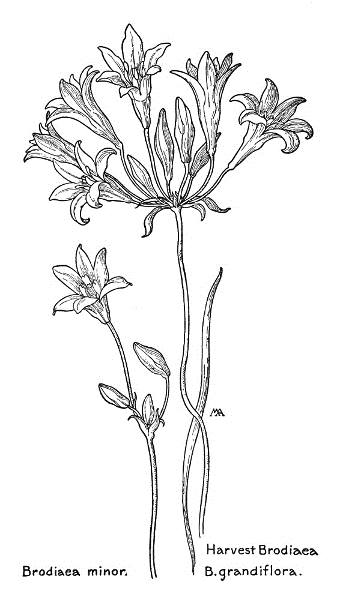
Brodiaea minor.
Harvest Brodiaea – B. grandiflora.

Twining Brodiaea
Brodiaèa volùbilis.
(Stropholirion Californicum)
Pink
Summer
California
This is a strange, rather grotesque-looking plant, with its slightly roughish, leafless, reddish stem contorted into curious curves, occasionally quite short but usually enormously long, sometimes as much as eight feet, and twining awkwardly in a snake-like way around and over the bushes in its neighborhood. There are sometimes a few long narrow leaves lying on the ground, but when the flower blooms they usually seem to have withered away. The flower-cluster is quite compact, sometimes six inches across, comprising from eighteen to twenty flowers, with several, large, pink, papery bracts. The flowers are rather pretty, dull pink outside but paler inside, the buds are deeper and more purplish pink, both of dry papery texture. The flowers are over half an inch across, their tubes and buds are six-angled, and they have three stamens with anthers and wings, alternating with three, notched, petal-like stamens, without anthers. In the spring the stem grows rapidly for several weeks and then the flower cluster begins to come out at the tip. If the stem is broken off the flower comes out just the same and the stem keeps on growing, even if it is brought into the house. These curious plants are found in the foothills of the Coast Ranges and the Sierra Nevada Mountains and may be seen in open sunny places along the stage route from Yosemite to Wawona. In the woods near Wawona I saw it twining around a very tall white larkspur and the combination was exceedingly pretty. The capsule is egg-shaped and pointed, the seeds black and angled.

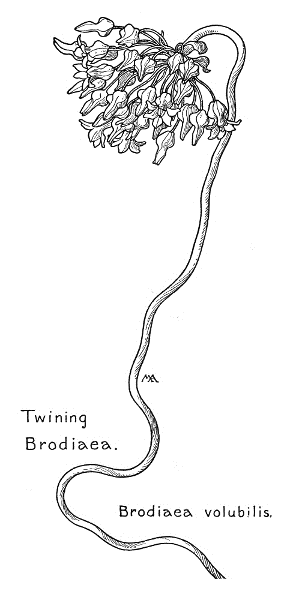
Twining Brodiaea – Brodiaea volubilis.

There are four kinds of Bloomeria, all Californian, resembling Brodiaea, but the stamens unlike. They have a fibrous-coated, solid bulb, long narrow leaves, and a bracted cluster of many flowers, at the top of a tall flower-stalk. The flowers are yellow, with six, nearly equal, spreading divisions, the six stamens on the base of the divisions, with slender filaments, which with a microscope are seen to have a short, two-toothed, hairy appendage at base. These are united and form a little cup surrounding the base of the stamens. The style is club-shaped, with a three-lobed stigma. The roundish capsule, beaked with the style, contains several, angular, wrinkled seeds in each cell.
Golden Stars
Bloomèria aùrea
Yellow
Spring, summer
California
In late spring the meadows around Pasadena and other places in the Coast Range are bright with pretty clusters of Golden Stars. The plant is from six to eighteen inches tall, springing from a small bulb, covered with brown fibers, with a long, narrow, grasslike leaf, and a large flower-cluster, sometimes comprising as many as fifty blossoms, at the top of the stalk. The flowers, about an inch across, with pedicels from one and a half to two inches long, are orange-yellow, the spreading divisions each striped with two dark lines, and the anthers are bright green. This looks very much like Golden Brodiaea, but the latter has no cup at the base of the stamens. It grows in the southern part of California and is abundant wherever it is found. B. Clevelandi is much the same, but the flowers are striped with green and the numerous buds are green, so that it is less golden and the general effect is not so good. It has numerous narrow leaves.

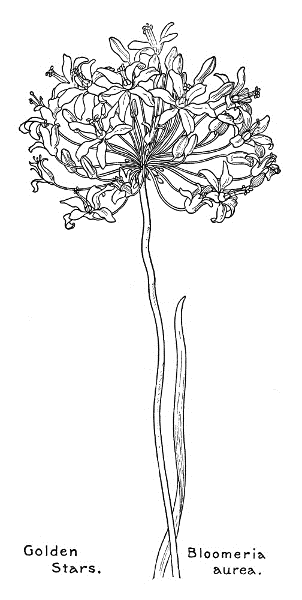
Golden Stars – Bloomeria aurea.
Triteleias resemble Brodiaeas, but they have six, swinging anthers and the ovary has a stalk.
Indian Hyacinth
Triteleìa grandiflòra (Brodiaea Douglasii)
Blue
Spring, summer
Northwest and Utah
Though the general appearance of the plant is very different, the individual flowers of this beautiful plant very much resemble the bells of a Hyacinth, for they have the same waxy, semi-translucent texture. The bluish-green leaves, folded lengthwise and withering before the flower, are sometimes a foot long and the flower-stalk often reaches a height of two feet and bends beneath the weight of its lovely crown of blossoms. The cluster has four papery bracts at the base and is from three to four inches across, comprising about a dozen flowers, each nearly an inch long. They are pale-violet, with a bright-blue mid-vein on each division, the general effect being blue, with a white pistil and six stamens in two rows, all with blue anthers and the outer ones with broad, white filaments. It is wonderful to find these lovely and exotic-looking flowers, delicately scented, gleaming in the shadow of a dusky oak thicket or a deep canyon. They last a long time in water, becoming papery as they wither.
White Brodiaea
Triteleìa hyacinthìna(Brodiaea lactea)
White
Spring
Cal., Oreg., Wash.
From one to two feet high, with very pretty flowers, about half an inch long, delicately striped with green on the outside, with six equal stamens, their filaments broad, triangular and slightly united at base, with yellow or purple anthers, and a green pistil. The leaf is grasslike, but thickish, and as long as the flower-stalk. These flowers are quite common and last a long time in water.
Ithuriel's Spear
Triteleìa láxa (Brodiaea)
Blue, purple
Spring
Cal., Oreg.
Very much like Harvest Brodiaea but rather taller, with more flowers in the cluster, and less waxy in texture, varying in color from blue to violet and occasionally white. This is common on hillsides and in adobe fields. The rather fanciful name was suggested by the spear carried by Milton's angel Ithuriel.
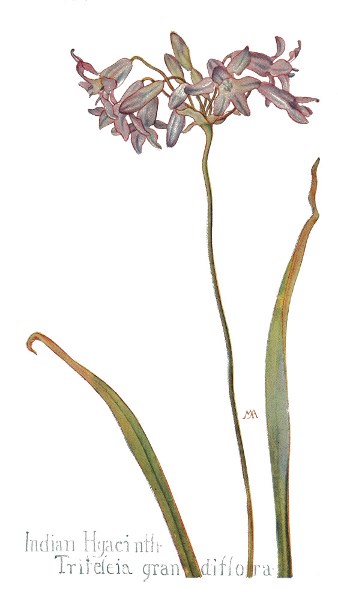
Indian Hyacinth – Triteleia grandiflora.
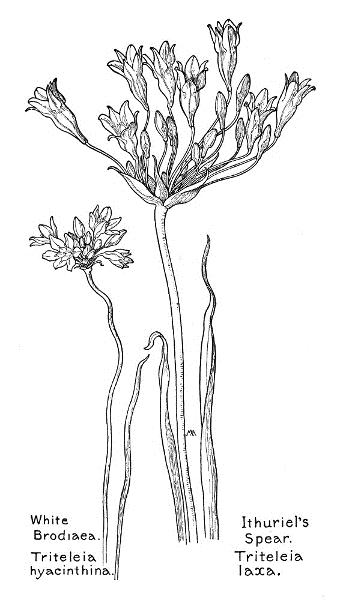
White Brodiaea – Triteleia hyacinthina.
Ithuriel's Spear – Triteleia laxa.
There are one or two kinds of Brevoortia.
Fire-cracker Flower
Brevoòrtia Ida-Màia (Brodiaea coccinea)
Red and green
Spring
Cal., Oreg.
A handsome plant, most extraordinary both in form and color. The stem is from one to three feet tall, with a few grasslike leaves, and bears a large cluster of six to thirteen flowers, one or two inches long, hanging on slender, reddish pedicels. They have bright-crimson tubes and apple-green lobes, sometimes turned back, showing the tips of the three pale-yellow anthers. There are also three stamens without anthers and broadened so that they look like three white or yellowish petals. The buds are also crimson, tipped with green, and the whole color scheme is wonderfully brilliant and striking. This grows in mountain canyons and on wooded hillsides, blooming in late spring.
There are several kinds of Muilla, much like Brodiaea and very much like Allium, but with no onion taste or smell.
Muilla
Muílla marítima
White
Spring
Cal., Nev.
A slender little plant, sometimes rather pretty, from three to nine inches tall, with sweet-scented flowers, about three-eighths of an inch or less across, white or greenish, striped with green outside, with six, bluish, swinging anthers. This grows in alkaline fields, on sea cliffs and mesas.
There are a good many kinds of Erythronium, all but one from North America, and, East and West, they are among our prettiest flowers. They have deep, membranous-coated, solid bulbs; a pair of netted-veined, unequal leaves, sometimes mottled with brown; flowers without bracts, large, nodding and bell-shaped, with usually six divisions, all colored alike, the tips turning back, each with a nectar-groove, and each with two or four little scales at base, or only the three inner divisions with scales; stamens on the receptacle, anthers not swinging; style more or less three-lobed; capsule more or less oblong and three-angled. The younger plants are often flowerless, with only one broad leaf, with a long leaf-stalk. The name is from a Greek word meaning "red," though these flowers are mostly yellow. The common name, Dog-tooth Violet, is old, and suggested by the little, white, toothlike offshoot often found on the bulb, but of course they are not in the least like Violets. In California they are often called Chamise Lily, and sometimes Adam and Eve, because the plant often bears a large and a small flower at the same time. Mr. Burroughs would like to call it Fawn Lily, on account of the mottled leaves of some kinds, which slightly suggest the ears of a fawn. Adder's-tongue, probably suggested by the long forked pistil, is also an old and usual name.
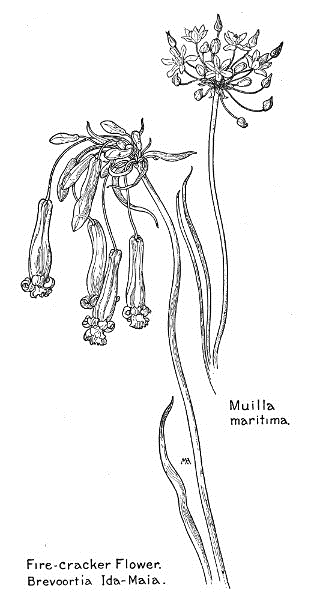
Muilla maritima.
Fire-cracker Flower – Brevoortia Ida-Maia.
Avalanche Lily
Dog-tooth Violet
Erythrònium montànum
White
Summer
Northwest
An exquisite kind, peculiarly graceful in form, with from one to nine, pure-white flowers, nearly three inches across, each petal prettily ornamented at the base with some orange-colored markings, arranged in a symmetrical scalloped pattern. The anthers are orange-yellow, the pistil white, the buds are pinkish and the leaves are very bright green and not mottled. This is very common around Mt. Rainier.
Glacier Lily
Dog-tooth Violet
Erythrònium parviflòrum
Yellow
Summer
Northwest
A lovely flower, much like E. grandiflorum, but the anthers are white or pale yellow. Around Mt. Rainier these beautiful plants often grow in large patches at the edge of the snow, alongside of the Avalanche Lily, E. montanum, but the two kinds do not seem to mingle.
Easter Bells
Dog-tooth Violet
Erythrònium grandiflòrum
Yellow
Spring, summer
Northwest and Utah
One of the loveliest of a charming group, growing in rich northern woods. The delicately-scented flowers, from one to six on a stalk, are about two inches across, clear yellow shading to white at the base, with purplish-red anthers, turning brown. A patch of these flowers bordering the edge of a glacier, as if planted in a garden-bed, is a sight never to be forgotten. Pushing their bright leaves right through the snow they gayly swing their golden censers in the face of winter and seem the very incarnation of spring. There are several similar kinds. In the Utah canyons these flowers in early spring are a wonderful sight, covering the wooded slopes with sheets of gold, and they seem to me to be the largest and handsomest of their clan, growing at an altitude of six thousand to eleven thousand five hundred feet, and blooming from March to July according to height. Easter Bells is a Utah name.
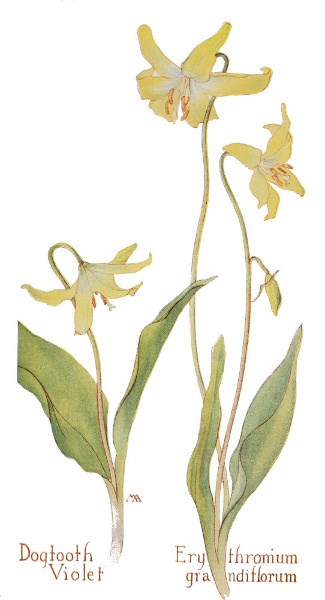
Dogtooth Violet – Erythronium grandiflorum.
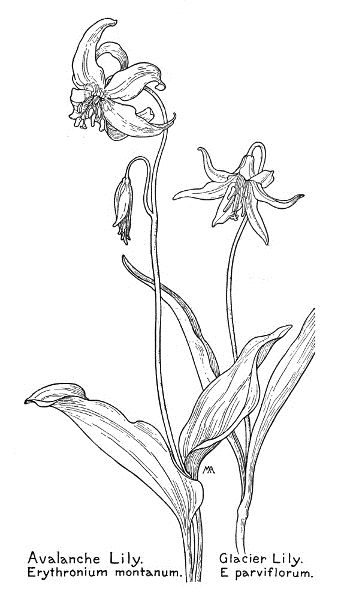
Avalanche Lily – Erythronium montanum.
Glacier Lily – E. parviflorum.

Desert Lily
Hesperocállis undulàta
White
Spring
Cal., Ariz.
This is the only one of its kind, a wonderfully beautiful desert plant, much like an Easter Lily. The stout, pale, bluish stem, from six inches to two feet tall, has a delicate "bloom" and springs from a graceful cluster of narrow leaves, which are a foot and a half long, spreading widely, but not lying quite flat on the ground. They are pale bluish-green, with a narrow, crinkled, white border and folded lengthwise. The buds are bluish and the lovely flowers are about three inches long and pure-white, delicately striped with pale-green and blue on the outside, with yellow anthers and a white stigma, and with a papery bract at the base of each pedicel. The flowers are slightly fragrant and become papery and curiously transparent as they wither. In dry seasons these plants do not bloom at all, but the slightest moisture will cause them to send up a stout stem and crown it with exquisite blossoms, which look extraordinarily out of place on the arid desert sand around Yuma and Ft. Mohave. The bulb is eaten by the Indians.

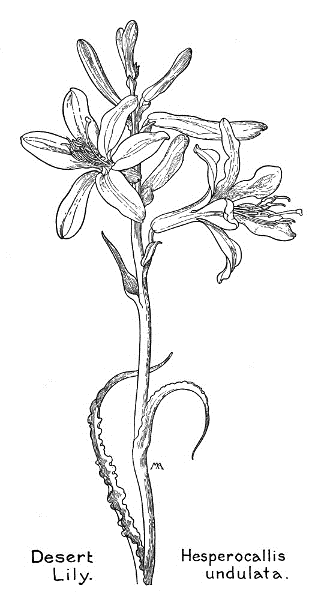
Desert Lily – Hesperocallis undulata.

Lilies, the "lords of gardens," are perhaps the most beautiful and popular flowers everywhere and there are some wonderful ones in the West. They have tall, smooth, leafy stems, springing from scaly bulbs; large showy flowers, solitary or in terminal clusters; smooth, netted-veined leaves, often in whorls, and leaflike bracts. The flower-cup is funnel-formed, or bell-shaped, and has six, equal, spreading divisions, with a honey-bearing groove at the base of each; the stamens, with long anthers, swinging from the tips of long filaments; a long pistil, with a three-lobed stigma and the capsule oblong, with two rows of flat seeds in each of its cells. There are no true Lilies in Utah.
Small Tiger Lily
Lílium párvum
Orange-red
Summer
Cal., Oreg.
These tall plants carry a brilliant crown of small lilies, glowing like jewels in the dark moist woods they love. The stem is from one and a half to six feet high, covered with a slight down that rubs off, and springs from a small bulb with short, thick scales. The long, pointed, rich-green leaves are in whorls of five or six below, more scattered towards the top of the stalk. The flowers are rather more than an inch long, yellow at the base of the petals, shading through orange to vermilion at the tips and dotted with crimson in the throat. Usually there are six or seven in a cluster, but they have been found with many more in favorable situations and single plants in Yosemite have been seen with as many as thirty blossoms. The capsule is roundish and less than an inch long. These little Lilies are among the most attractive of their kind and grow somewhat freely in the high Sierras to an altitude of seven thousand feet and as far north as Oregon.

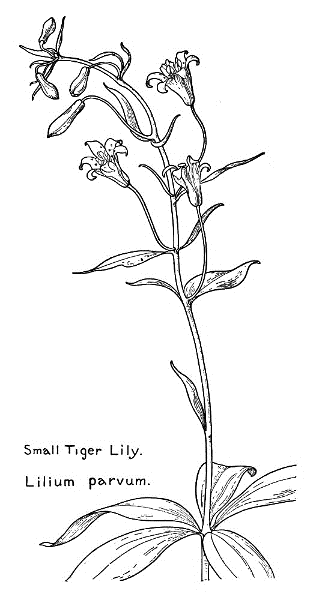
Small Tiger Lily – Lilium parvum.

Washington Lily
Shasta Lily
Lílium Washingtoniànum
White
Summer
Cal., Oreg.
In the Sierras, at an altitude of from three to over seven thousand feet, and as far north as the Columbia River, we may be fortunate enough to find this glorious Lily, growing in the forest in moderate shade and protected by the chaparral. It is not rare but nowhere very abundant. I shall never forget finding a group of three or four, growing near a huge fallen tree, in the woods at Wawona near Yosemite, where it is very fine. Their raiment is even more "white and glistering" than the cultivated Easter Lilies. The smooth, stout, purplish stem is from two to five feet high, adorned all the way up with successive whorls of handsome dark-green leaves, three or four inches long, thin in texture, with rippling margins, and shining as if they had been varnished. There are from two to twenty blossoms of shining white, each one from three to four inches long and as much across. The petals are cleft to the base, spreading wide apart when the flower is fully open, sometimes finely dotted with purple, and becoming purplish in fading. The anthers are yellow and the pistil green, and the bulb is large, with thin scales. The scent is delicious, having a whiff of spicy carnation added to the usual lily fragrance. This is never found in the Coast Range and is the only pure white American Lily. Shasta Lily is a variety with a small bulb. L. Párryi, the Lemon Lily, of southern California and Arizona, is similar in the form of its flowers, which are large and clear yellow, dotted lightly with deeper yellow. It grows in shady, moist spots in cool canyons and is very beautiful.

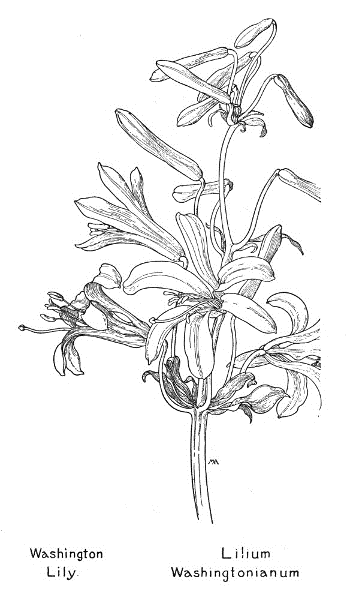
Washington Lily – Lilium Washingtonianum.
Leopard Lily
Lílium pardalìnum
Orange
Summer
Wash., Oreg., Cal.
A magnificent plant, from three to six feet tall, with bright-green leaves, thin in texture, smooth but not shiny, and mostly in whorls. The stem is crowned by a splendid cluster of flowers, usually about half a dozen together, but sometimes as many as thirty on one stalk. They measure three or four inches across and are pale-orange outside and deep-orange inside, spotted with maroon, often blotched with orange-yellow in the throat and tipped with scarlet. The anthers are purplish, changing to reddish-brown, and the pistil is bright-green. These plants often grow in large companies, in moist spots in the mountains, and are unrivaled in decorative beauty and brilliancy of coloring.
Tiger Lily
Lílium Columbiànum
Orange
Summer
Wash., Oreg.
A good deal like the last, but not so large. The petals are more turned back and they are orange-color all over, dotted with dark-red, and the anthers are pale orange-color, ripening to golden-brown. This is common in the Hood River Valley.
Ruby Lily
Chaparral Lily
Lílium rubéscens
White, pink
Summer
Cal., Oreg.
A glorious plant, from two to five feet tall, with leaves mostly in whorls, with rippled edges. The stem bears a magnificent cluster of blossoms, most wonderful in coloring, for the buds and young flowers are white, dotted with purple inside, with yellow anthers and a pale-green pistil, but they gradually change to pink, and deepen to ruby-purple as they fade, and the anthers and pistil also darken in color. The effect of the whole cluster is therefore white at the top, shading through pink to almost crimson below. The flowers are even more deliciously fragrant than the Washington Lily, which they resemble, except that they are not quite so large as the latter and stand more erect and the petals are not so spreading. This usually grows among chaparral in the Coast Ranges.
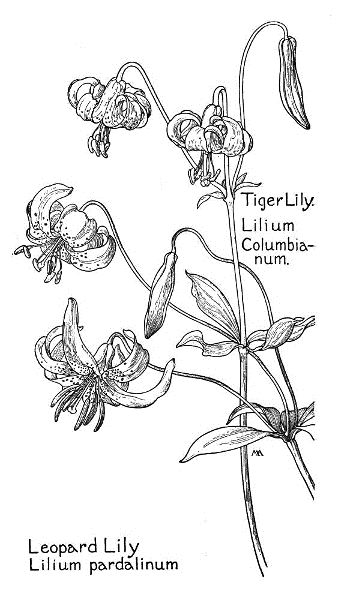
Tiger Lily – Lilium Columbianum.
Leopard Lily – Lilium pardalinum.
There are many kinds of Fritillaria, natives of the north temperate zone. In the East there are only cultivated ones, such as the familiar Crown Imperial, but we have a number growing wild in the West. They have bulbs with round, thick scales, developing into bulblets and sometimes resembling grains of rice. The flowers are bell-shaped, and nodding, with separate and nearly equal divisions, each with a nectar-spot at its base. They resemble Lilies, but the style is three-cleft, the honey-gland is a shallow pit and the flowers are smaller. The capsule is roundish and six-angled, containing numerous flat seeds. It is conspicuous and perhaps suggested the Latin name, meaning "dice-box."

